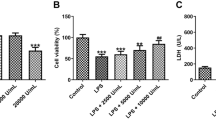Abstract
Ochratoxin A (OTA) is a mycotoxin showing nephrotoxic properties. OTA activates the mitogen activated protein kinases ERK, JNK and p38 in renal epithelial cells. In brief, activation of ERK supports mitosis, growth and differentiation, whereas JNK and p38 are considered to induce the opposite effects. The balance of the mentioned key protein kinases decides the further fate of the cell. In renal disease, the proximal tubule of the nephron often is affected first.
Thus, we investigated the effect of OTA incubation (24 or 48 hours) on proximal tubular OK cells (oppossum) and/or NRK-52E cells (rat) in presence of an inhibitor of ERK1/2 activation (U0126). U0126 (25 µM) completely abolished ERK1/2 activation induced by OTA. Parameters indicating necrosis, apoptosis, epithelial tightness, fibrosis, dedifferentiation and inflammation were determined. In presence of U0126, OTA led to a decrease of cell number as compared to OTA alone. U0126 in presence of OTA increased LDH release as compared to OTA alone. OTA alone did not change epithelial integrity, whereas OTA in presence of U0126 reduced epithelial tightness. 100 nM OTA alone did not increase apoptosis, while addition of U0126 to OTA induced apoptotis. U0126 stimulated the basolateral deposition of collagen induced by OTA. Furthermore, as investigated by RT-PCR, the effect of OTA on markers of inflammation (NF-κB) and dedifferentiation (α-smooth muscle actin) was also more pronounced when ERK1/2 was inhibited. ERK1/2 inhibition enhanced the effects of OTA. Thus, activation of ERK1/2 after OTA is a protective mechanism. We conclude that ERK1/2 not only acts anti-apoptotic but also is beneficial on cell viability, epithelial tightness, interstitial fibrosis, inflammation and trans-differentiation. We further conclude that ERK1/2 is a key protection factor in the proximal tubule. However, long term OTA exposition could lead to clonal selection of kidney cells overexpressing ERK1/2. As strong expression of ERK1/2 is found in various tumours not only of the kidney, we hypothesize that the mentioned clonal selection could be a mechanism inducing the cancerogenic action discussed for OTA.
Similar content being viewed by others
References
Krogh P, Axelsen NH, Elling F, et al: Experimental Porcine Nephropathy. Acta Pathol Microbiol Scand A. Suppl.No.246:1–21, 1974
Van Montfoort JE, Hagenbuch B, Groothuis GM, et al: Drug uptake systems in liver and kidney. Curr Drug Metab 4:185–211, 2003
Chang L, Karin M: Mammalian MAP kinase signalling cascades. Nature 410:37–40, 2001
Schramek H, Wilflingseder D, Pollack V, et al: Ochratoxin A-induced stimulation of extracellular signal- regulated kinases 1/2 is associated with madin-darby canine kidney-C7 cell dedifferentiation. J Pharmacol Exp Ther. 283:1460–1468, 1997
Maaroufi K, Achour A, Hammami M, et al: Ochratoxin A in human blood in relation to nephropathy in Tunisia. Hum Exp Toxicol 14:609–614, 1995
Wafa EW, Yahya RS, Sobh MA, et al: Human ochratoxicosis and nephropathy in Egypt: a preliminary study. Hum Exp Toxicol 17:124–129, 1998
Stoev SD: The role of ochratoxin A as a possible cause of Balkan endemic nephropathy and its risk evaluation. Vet.Hum.Toxicol. 40:352–360, 1998
Montesano R, Soriano JV, Hosseini G, et al: Constitutively active mitogenactivated protein kinase kinase MEK1 disrupts morphogenesis and induces an invasive phenotype in Madin-Darby canine kidney epithelial cells. Cell Growth Differ 10:317–332, 1999
Santen RJ, Song RX, McPherson R, et al: The role of mitogen-activated protein (MAP) kinase in breast cancer. J Steroid Biochem Mol Biol 80:239–256, 2002
Huang C, Ma WY, Li J, et al: Requirement of Erk, but not JNK, for arsenite-induced cell transformation. J Biol Chem 274:14595–14601, 1999
Author information
Authors and Affiliations
Rights and permissions
About this article
Cite this article
Sauvant, C., Holzinger, H. & Gekle, M. Inhibition of the mitogen activated protein kinase ERK1/2 amplifies ochratoxin A toxicity in the proximal tubule of the kidney. Mycotox Res 19, 118–123 (2003). https://doi.org/10.1007/BF02942949
Issue Date:
DOI: https://doi.org/10.1007/BF02942949




